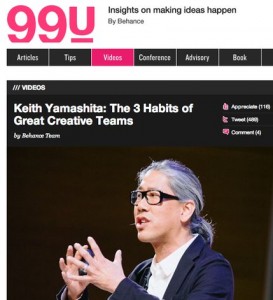Brands
Behance’s Blanda on Branded Content, Journalism and the Power of Sources
This post is part of the Content Q&A Series, featuring interviews with top content strategists and bloggers about their work and insights about the industry.
Brands creating content these days often steal a few tricks from features journalism to tell stories. Even more commonly, brands hire former journalists to run content marketing initiatives.
 For journalists, how do the two tasks compare?
For journalists, how do the two tasks compare?
Some traditionally trained journalists say they worry that articles or blog posts seem less trustworthy if the content is produced by a brand, but in practice that tends to not be the case.
Brands such as Birchbox and Behance have created editorial destinations that are utility driven and meet the readers’ needs the same way features writing always has.
The Content Strategist talked to Sean Blanda, associate editor and producer at Behance, about his experience moving from journalism to developing content for a brand, and the similarities and differences in each.
The Content Strategist: How did you get into brand content and what did you do before?
Blanda: Before this, I was in Philadelphia working on a company I started with two friends of mine called Technically Philly — it’s kind of the TechCrunch for Philadelphia.
 We covered startups, entrepreneurs and venture capital, but out of that, one of the ways we made money in the early days, was with what people now call content marketing for brands.
We covered startups, entrepreneurs and venture capital, but out of that, one of the ways we made money in the early days, was with what people now call content marketing for brands.
The more I immersed myself in it the more I realized that features journalism — not like hard news, political reporting, investigative journalism — but features writing for the features section, or the style section, that kind of journalism and content marketing are not that dissimilar. They have a lot to learn from each other. I felt the skills readily transferred between each one and was kind of excited, I saw this whole untapped universe of brands not really being met.
In respect to content, what are your goals at Behance?
Blanda: The goals with content is primarily executed through 99U, which is a conference and a blog we run. The tagline is making ideas happen — we get enough inspiration every day but how do we put our nose to the grindstone and crank out all the great work we can do.
The blog is to kind of motivate and get people to that message and hopefully they’ll buy a notebook, or attend a conference, or join the Behance network. It’s another way for people to get sucked into the Behance universe.
How is what you do now similar to journalism, and how is it different?
Blanda: I don’t view what we do at 99U as that dissimilar to features journalism. So, like reaching out to people, interviewing them, getting the takeaway, its just like service journalism, finding ways to help our readers. Instead of selling subscriptions, we’re selling conference tickets.
 The only different is we play a small role in also trying to monetize the things we do. In a traditional old school journalism environment that didn’t happen.
The only different is we play a small role in also trying to monetize the things we do. In a traditional old school journalism environment that didn’t happen.
[At Technically Philly,] I acted as a publisher, publisher writer and editor all rolled into one as a necessity. Because you only have a staff of three, it’s hard to do the traditional walled-off gardens that used to exist. So I think nowadays, you’re doing a disservice if you want to create content but you’re not figuring out ways to monetize — in a way that makes sense. Not just ads or a paywall, but what does your audience want that based on your expertise and access you can give them, to make their lives better.
What are the most important skills to succeed in the space right now?
Blanda: You can learn how to write, you an learn how to edit, you can learn how to interview, but the one thing I think that you need in this space is a constant curiosity to try out new ways of reaching your audience and new ways of providing for your audience.
So I think it’s really easy to just say to yourself, I’m a writer, and not really bother yourself with that. I think those kinds of people are going to be left behind really quickly. If you’re not afraid to experiement and try new stuff you’ll eventually end up on top — it might be hard in the beginning, but youll eventually end up on top.
What’s one thing you’re working on right now?
Blanda: The biggest thing we have coming up is our 99U conference, which is kind of like a lecture series, a bootcamp for creating, to come and really get a butt-kicking in making their ideas happen. So we’re gonna have a few days of speakers and some action classes as well as studio session tours all throughout New York City.
We promote it through the blog all the time. We interview people who have spoken or wil speak on the site, record the lectures, and those are then streamed up on 99u.com so if you got to 99u.com/videos you can see the last three years, I believe.
Any industry-related pet peeves?
Blanda: A lot of journalists don’t recognize the power your sources have. Sources can make their own platform now, and sources can build an audience way larger than the journalists sometimes. And I think a lot of people aren’t really atuned to that, there’s still a few people catching up.
Think about 37signals, they have their film blog Signal vs. Noise, they have their book series, they talk often at a lot of conferences, but do they really need the attention? Probably not. And I think that’s a rising trend we’re gonna see.
If [journalists] don’t react quickly to that kind of trend they’re going to get left behind. They need to provide value. Before the value of a journalist doing an interview was, Hey I’m going to give you my audience but what happens when your audience is bigger than my audience? Does it matter anymore?
Get better at your job right now.
Read our monthly newsletter to master content marketing. It’s made for marketers, creators, and everyone in between.




